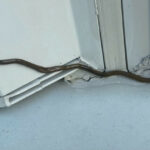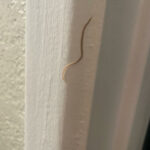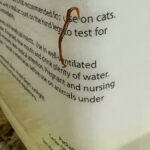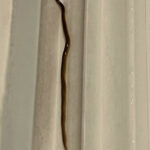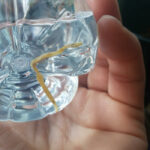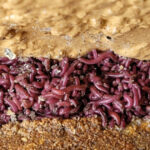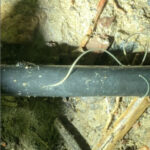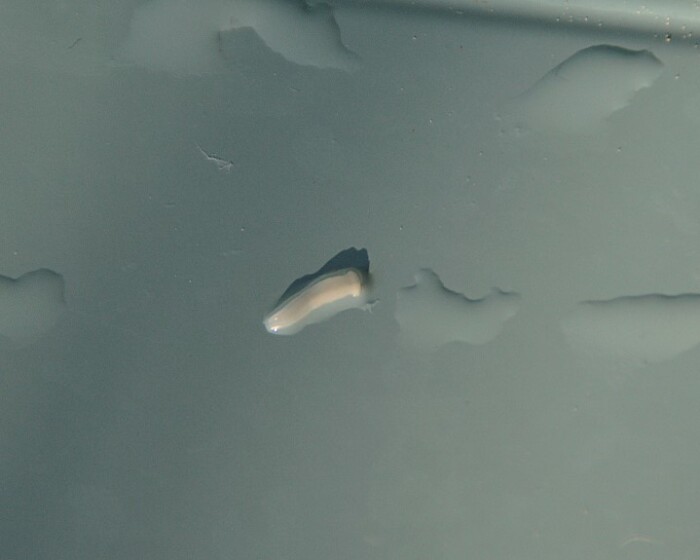
“Found on my desk when my cat jumped down”, writes Beverly about the “shape shifting”, white organism pictured below. “Approximately 1/2 an inch when elongated. I tried to kill it with insect repellent – no effect. Put it on a tray to photograph. It made the shape of a round blob, then a flattened square, a triangle next, before finally reaching out from the blob when changing directions, from no set point.” Beverly sent us multiple photographs, a couple of which we have included below that show these different shapes the organism makes. Now, provided this creature is worm-like, it would be flexible enough to contort its body in many different ways, which is a more plausible explanation than shape-shifting. Many worm-like organisms, such as the earthworm, can flex and relax the muscles in their body, which will extend and shorten their bodies, which can look as if the worm is changing shape. Likewise, slugs are able to do the same; when they feel threatened, they can effectively withdraw their head and antennae into their bodies and become a “blob” where before they were an elongated shape.
Speaking of slugs, we think it is possible that the critter Beverly found is a baby slug. Typically, when we think of slugs, we think of the typical brown garden slug, or the black slugs. Or, God forbid, the banana slug. But there are indeed species white slugs. We cannot tell exactly what species this one is, as it is so small and underdeveloped. In the first photo below, we believe that the spade-shaped is where the head is, and the two ‘tips’ are where the antennae will grow in. Now, although we have been referring to these appendages as antennae, they are actually referred to as tentacles since they are mollusks just like octopuses. Slugs actually have two pairs of tentacles, and each pair has a different function. The top pair houses the ‘eyes’, which sense light, while the bottom pair is essentially their nose, meaning they are used for smelling. They also have great instincts and fantastic abilities. For example, a slug will follow its own trail of slime back to its burrow once it is ready to return home after an excursion. Likewise, slugs are able to self-decapitate to escape a predator, and will, over time, regenerate the rest of their body. If this is a slug, then that is why Beverly would have been unsuccessful in killing it with insect repellent. That is not to say that the repellent did not harm the slug, and it could have been the process of its regeneration that seemingly made it shape-shift.
Now, we cannot know for certain that this is a slug – that is just our best educated guess. Given how small it is, it is still possible that this is some other type of organism. Plus, since Beverly implies that the organism could possibly have something to do with her cat, we cannot provide a certain identification given the possibility that it came from her cat or that it is negatively affecting its health. Since we are not medical professionals, we are neither qualified nor legally able to identify organisms affecting humans or pets. As such, we recommend that she take her cat to the vet. Likewise, if she is worried about her own health in relation to the discovery of this worm, we suggest she seek the attention of a medical parasitologist.
To find a medical parasitologist or other health care provider who can actually help, Beverly can do one or more of the following:
– Visit our parasite care resources page here: https://www.allaboutworms.com/get-medical-attention-and-tests-for-parasites
– Search for a medical parasitologist in her area using this directory of medical parasitology consultants: https://www.astmh.org/for-astmh-members/clinical-consultants-directory.
– Search for a local parasitologist by doing a Google search for “medical parasitologist (name of the closest big city)” or “tropical medicine specialist (name of the closest big city)”.
In conclusion, we think it is possible that the white worm-like creature Beverly found on her desk is a baby slug, based on the way it contorts its body, and the tentacle-like appendages that seem to be growing from its head. Of course, we cannot be entirely certain of this identification, so we urge Beverly to seek medical attention for her cat if she sees fit. We hope this helps, and we wish Beverly and her cat the very best!
All About Worms is always free, always reader-supported. Your tips via CashApp, Venmo, or Paypal are appreciated! Receipts will come from ISIPP Publishing.
You might also find these guys interesting!





